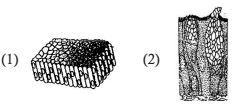Structural Organisation in Animals
- Histamine secreting cells are found in
-
View Hint View Answer Discuss in Forum
In connective tissues, histamine is an organic nitrogen compound involved in local immune responses and regulating physiological function in the gut and it acts as a neurotransmitter. Histamine is produced by basophils and mast cells found in nearby connective tissues.
Correct Option: A
In connective tissues, histamine is an organic nitrogen compound involved in local immune responses and regulating physiological function in the gut and it acts as a neurotransmitter. Histamine is produced by basophils and mast cells found in nearby connective tissues.
- The four sketches (1, 2, 3 and 4) given below, represent four different types of animal tissues. Which one of these is correctly identified in the options given, along with its correct location and function?


Tissue Location Function
-
View Hint View Answer Discuss in Forum
Glandular epithelium invaginates epithelia into connective tissue which differentiate into secretory units. Examples include sebaceous glands of the skin and glands in the intestinal lining (exocrine glands), and many endocrine glands releasing hormones, such as the thyroid follicle.
Correct Option: A
Glandular epithelium invaginates epithelia into connective tissue which differentiate into secretory units. Examples include sebaceous glands of the skin and glands in the intestinal lining (exocrine glands), and many endocrine glands releasing hormones, such as the thyroid follicle.
- Identify the tissue shown in the diagram and match with its characteristcs and its location

-
View Hint View Answer Discuss in Forum
Skeletal muscle tissue is closely attached to sketetal bones. In a typical muscle such as the biceps, striated (striped) skeletal muscle fibres are bundled together in a parallel fashion.
Correct Option: A
Skeletal muscle tissue is closely attached to sketetal bones. In a typical muscle such as the biceps, striated (striped) skeletal muscle fibres are bundled together in a parallel fashion.
- Areolar connective tissue joins
-
View Hint View Answer Discuss in Forum
Areolar connective tissue has rich supply of nerve fibres and blood vessels. It joins skin epithelia with muscles, nerves & blood vessels. Binding of body parts together is the main function of areolar connective tissue.
Correct Option: A
Areolar connective tissue has rich supply of nerve fibres and blood vessels. It joins skin epithelia with muscles, nerves & blood vessels. Binding of body parts together is the main function of areolar connective tissue.
- Blood capillary consists of
-
View Hint View Answer Discuss in Forum
The wall of blood vessels (arteries & veins) are made up of mainly 3 layers – the outer most tunica externa has a loose connective tissue, collagen fibres, lymph vessels and the middle tunica media has circular smooth muscle fibres, some elastic fibres and the inner most tunica interna is a single layered endothelium of polyhedral squamous cells. If the arteries reach organs they form arterioles which are thinner and mainly consist smooth muscles and when they subdivide in the tissues they make capillaries. The wall of capillaries are very thin (usually less than one micron) and have numerous minute pores and made up of only endothelium. Exchange of material takes place between blood and tissue fluid across the endothelial membrane of capillaries through active diffusion.
Correct Option: A
The wall of blood vessels (arteries & veins) are made up of mainly 3 layers – the outer most tunica externa has a loose connective tissue, collagen fibres, lymph vessels and the middle tunica media has circular smooth muscle fibres, some elastic fibres and the inner most tunica interna is a single layered endothelium of polyhedral squamous cells. If the arteries reach organs they form arterioles which are thinner and mainly consist smooth muscles and when they subdivide in the tissues they make capillaries. The wall of capillaries are very thin (usually less than one micron) and have numerous minute pores and made up of only endothelium. Exchange of material takes place between blood and tissue fluid across the endothelial membrane of capillaries through active diffusion.

